Last updated on September 5th, 2024 at 03:40 am
Last Updated on September 5, 2024 by
Live oak trees on the Mississippi Gulf Coast are a national treasure. These magnificent trees can live for hundreds of years and span more than 150′ providing food and shelter for birds and animals. When you visit the Mississippi Gulf Coast one of the first things you will see is the live oaks lining streets in older areas of the Coast.
My first view of a large group of these trees was a drive down Washington Avenue in Ocean Springs. The canopy they form shelters people from the hot sun and adds to the beauty of the area.
You are probably like me, not a botanist so Latin names of plants and trees mean little to you. The Southern live oak called Quercus Virginiana to be specific is found in the Southern United States from the East Coast to Texas. Hundreds of them have been around longer than the United States has been a country. This tree produces acorns that feed animals and some humans.
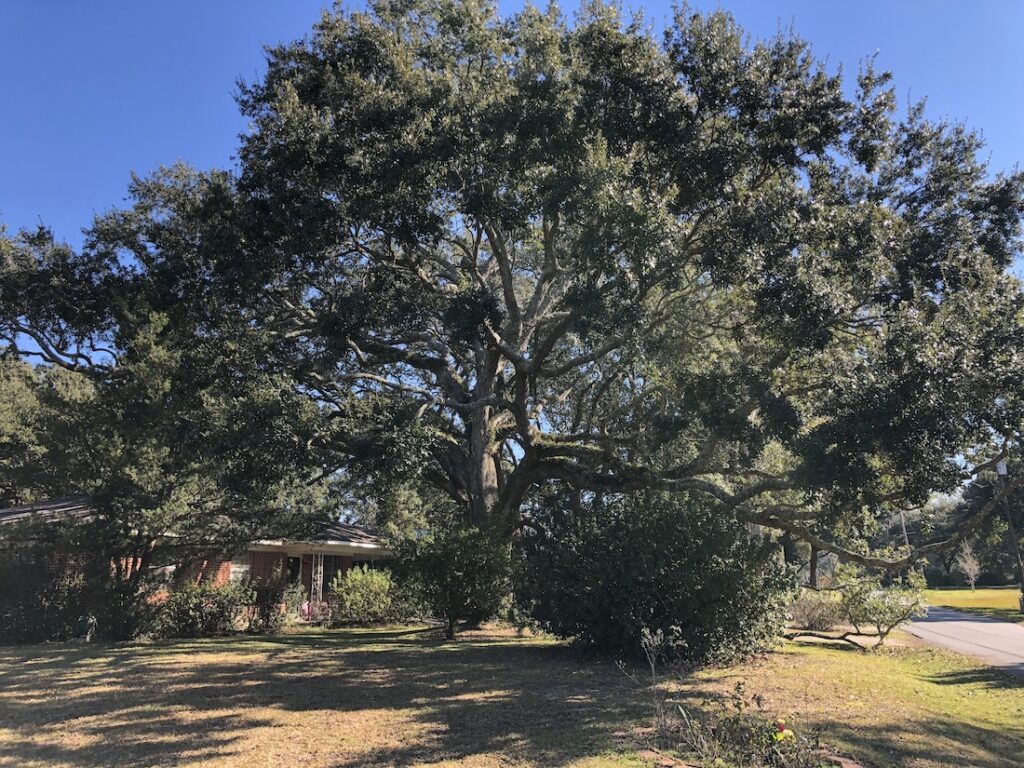
These same trees may have fed indigenous people
They were a staple of indigenous peoples. The tree is evergreen meaning that the leaves stay on the tree all year. The remarkable thing about these trees is that while they can grow very high, they tend to spread out much further than they grow tall.
According to the University of Southern Mississippi, a live oak reaches full growth at age 70. “Friendship Oak”, located at the University of Southern Mississippi is estimated to be over 500 years old. A local restaurant, Mary Mahoneys is said to have a live oak over 2,000 years old. Some experts think it’s between 500 and 600 years old. Regardless, it’s a beautiful tree, and other than losing leaves during Katrina, it stands against time and mother nature.
Mississippi’s Gulf Coast is not the only area in the South where Southern Live Oaks can be found. My research indicated that perhaps the oldest known southern live oak in the United States is located in South Carolina called “Angel Oak” and is estimated to be more than 1,500 years old.
Imagine, older than any person who came to this country from Europe during the age of discovery. Consider this, the Roman empire was still around when this tree started growing. Most noteworthy is that Angel Oak is more than 65′ high and its branches spread more than 139′ wide.
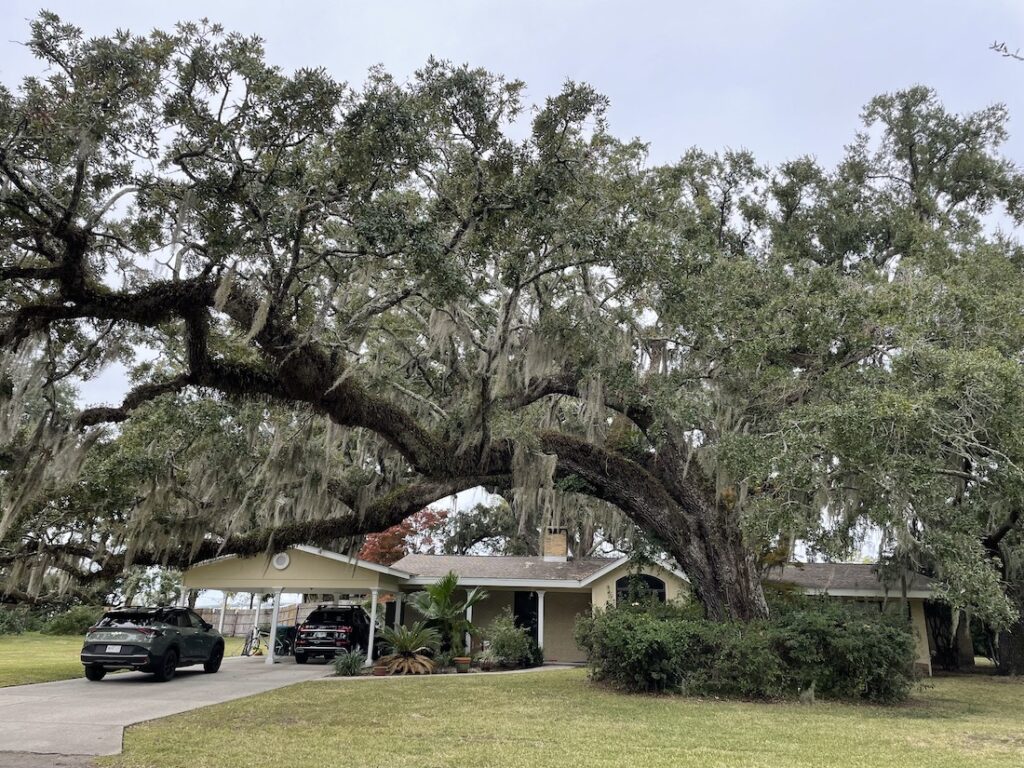
Live oaks often cross a street
When you drive down Beach Boulevard on the Mississippi Gulf Coast, you will see many of these great trees in yards and creating a canopy effect across the highway. I was driving my motor home along the street and was in fear that it would hit some of the trees.
Thankfully all of the trucks and busses that have come before me act as a tree-trimming effort. You will see these great trees at many historic landmarks throughout the South and in particular at old mansion-style houses where they were planted for shade in the mid-1800s.
An amazing thing is that there are so many very old trees on the Mississippi Coast after perhaps dozens of hurricanes over the many decades they have been around. The big storm surge after Hurricane Katrina destroyed some trees because of the saltwater intrusion in the roots but more survived than were taken down. It seems that every historic home has some old trees, again planted for shade.
Spanish moss hanging from the trees
A feature of many of these old Southern live oak trees is the Spanish moss that hangs off of their branches. You can see this walking or driving around some of the old towns along the Mississippi Gulf Coast in Ocean Springs, Bay Saint Louis, and other old downtowns.
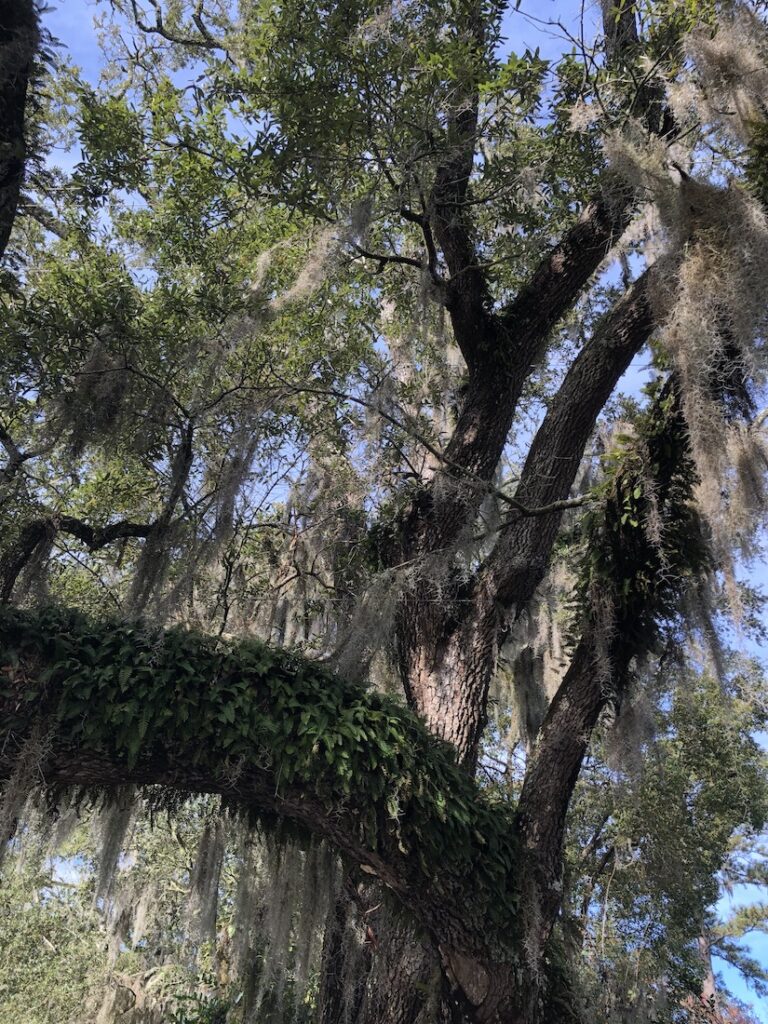
The average mature Southern live oak can consume 50 gallons of water through its tap root. These trees shed acorns which are a primary food supply for squirrels, deer, and other animals. The wood produced by these trees is very dense, among the hardest of all hardwoods. A cubic foot of a live oak can weigh 75 pounds.
Spanish Moss, what is it?
Spanish moss is a common sight in the Southern United States, often hanging in long, gray strands from trees. Despite its name, it’s actually not a moss. Instead, it’s a flowering plant in the bromeliad family, related to pineapples.
Key characteristics of Spanish moss include:
- Epiphytic nature: It grows on other plants, usually trees, for support.
- Grayish color: Its strands are typically gray or silvery.
- No roots: It absorbs nutrients and water from the air and rain.
- Slow growth: It can take years to grow to its full length.
While Spanish moss can add a distinctive look to landscapes, it can also become a nuisance if it grows excessively. It can clog gutters, damage trees, and even create a fire hazard.
Southern live oaks are resistant to disease and decay which made them excellent for shipbuilding. The young United States government was very concerned about the supply of Southern live oak trees that they reserved thousands of acres of woodlands in the South to protect the trees from timber cutters. President John Quincy Adams even established a federal tree farm in the area of Gulf Breeze, Alabama.
One of the largest live oak tree reservations was located in Biloxi. At the end of the Civil War, the United States government gave the land to the City of Biloxi. The tree reserve was eventually used to build Keesler Air Force Base, the Biloxi National Cemetary, and the Veteran’s Administration Hospital Complex.
War of Independence relied on live oak for ships
The U.S.S. Constitution located in Boston Harbor was constructed in part through the use of live oak trees from Georgia. After one sailing and battles with the enemy, the Constitution returned with dozens of cannon balls embedded in the hull, none had penetrated.
Many ships used live oak to create critical support elements for hulls. Shipbuilding in earlier years is one reason that there are not more very old trees around. It’s a good thing for our heritage that steel ships came along and the need for southern live oak trees in shipbuilding died away.
I am proud to say that I own several very old southern live oaks. One is located in front of a house that was built in 1905 which I use as a vacation rental. People love the great tree. Over the years it has been necessary to keep some branches from growing over the house. The tree entirely overhangs the street but at a height that trucks can clear. The same property has several other very large and old live oaks.
During a hurricane a few years ago, the tree lost a large branch measuring at least 20″ thick. We cut it and used it as firewood.
I own large very old live oak trees
Another very large and old southern live oak is located at my office. Fortunately, it was planted near the street so the branches which stretch over the street do not reach the building which is a house built in the 1930s. All of my trees are healthy and I consider them as adding to the property value. It’s nice to have leaves all year, particularly in the winter. The squirrels and birds gather the acorns when they fall.
The City of Long Beach residents want to keep a tree
Communities along the Mississippi Gulf Coast consider southern live oaks along with magnolias (the state tree) to be part of their cultural heritage. One such coastal community that takes removal or destruction of southern live oaks is the city of Long Beach.
Perhaps in part because one of the oldest trees in the South is located in the city. When the tree is over 8″ thick, the ordinance requires a valid tree removal permit to remove a southern live oak or magnolia. A case must be made to the City about why the tree is to be removed.
Often there is a way to build around the tree or trim the tree so that it will accommodate the construction. The city has been known to approve the removal of some old-growth southern live oaks. Recently residents jammed a city council meeting to prevent the destruction of a very old tree by developers building a hotel.
Coastal Mississippi residents value their old oak trees and will often object to the removal of legacy trees. View the Utube video below that shows you just how passionate people in the City of Long Beach are about “their” trees. You see, old-growth southern live oaks are considered by the community to be a shared asset even when they are located on private property.
There is something about a beautiful old tree that many have grown up with which causes a lot of people to react to anyone wanting to remove one. https://www.wlox.com/2023/02/10/long-beach-residents-continue-fight-keep-oak-tree/
More on the Long Beach tree issue
I want to elaborate on the issue at the City of Long Beach. This is just how serious residents are about their treasures. In this case, a developer wants to build a hotel on land that has been vacant for some time. The developers would like to remove the tree. They have requested that the City permit them to cut down the tree to complete their project.
Residents have consulted an arborist to determine if limbs can be cut without harming the tree. The arborist after assessing the tree concluded that the tree would indeed survive with some surgery.
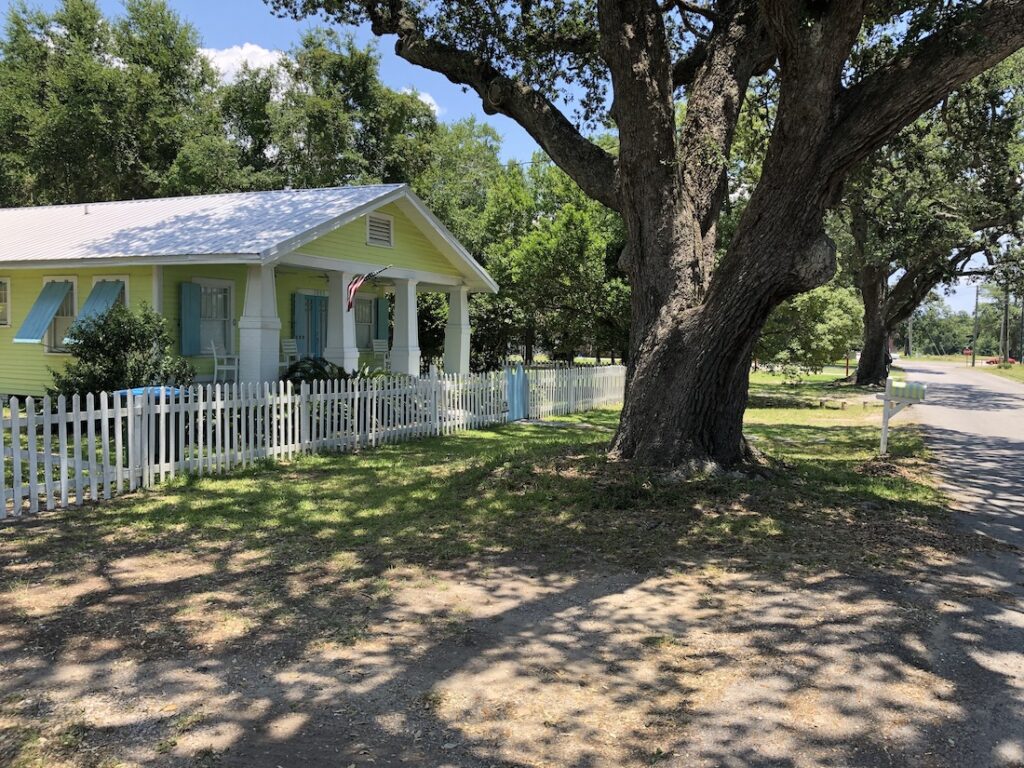
The mayor among others encouraged the developers to allow the arborist to trim the tree. This is his opinion would accommodate their plans without removing the tree. Parties have had a chance to speak at a city council meeting. The council is still considering the matter.
I have worked with local governments around the country for decades in my previous life. Unless there is a major issue such as this one, few people usually attend a regular meeting.
That does not happen very often so when you see the crowded council chamber you know that this issue has hit a “nerve” of the public. It won’t go away without some compromise.
UPDATE: Long Beach Live Oaks
The garden club lost the fight. The developers have removed the trees.
Many people find ways to build around live oak trees
These great natural wonders have some protection and fortunately, it seems many people take care to build around them and protect them during the building process. it may have taken several hundred years for the tree to grow. Some considerations of the plan to save the tree should be on the table. The Long Beach ordinance and those of other cities indicate that they can not unreasonably deny the property owner’s request.
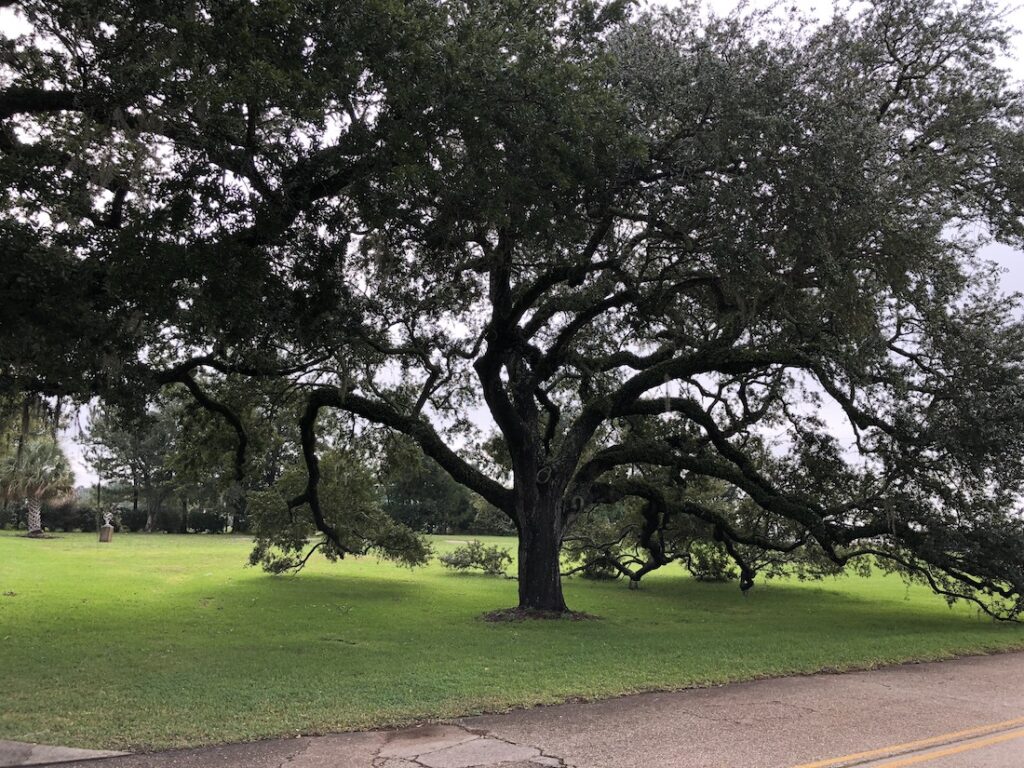
Some of these trees were old when Christopher Columbus discovered the Americas. Perhaps local indigenous tribes gathered acorns and lived under the branches of some live oaks. These majestic live oaks are part of the fabric of the Mississippi Gulf Coast.
Have you seen a bench built around a southern live oak tree? That bench is a shoo-fly.
What’s a shoo-fly?
A Shoofly is a unique form of Mississippi architecture. These came into fashion in the 1800s when people came to the Mississippi Gulf Coast for vacation. According to Mississippi Enyclopedia, some could accommodate up to 30 people.
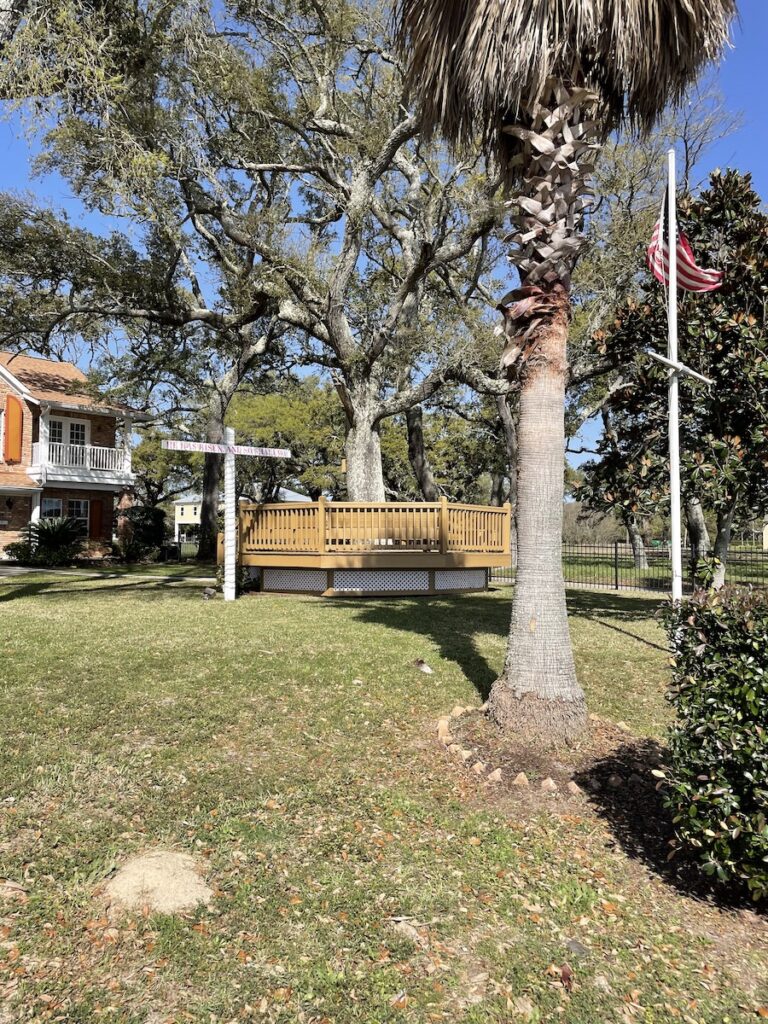
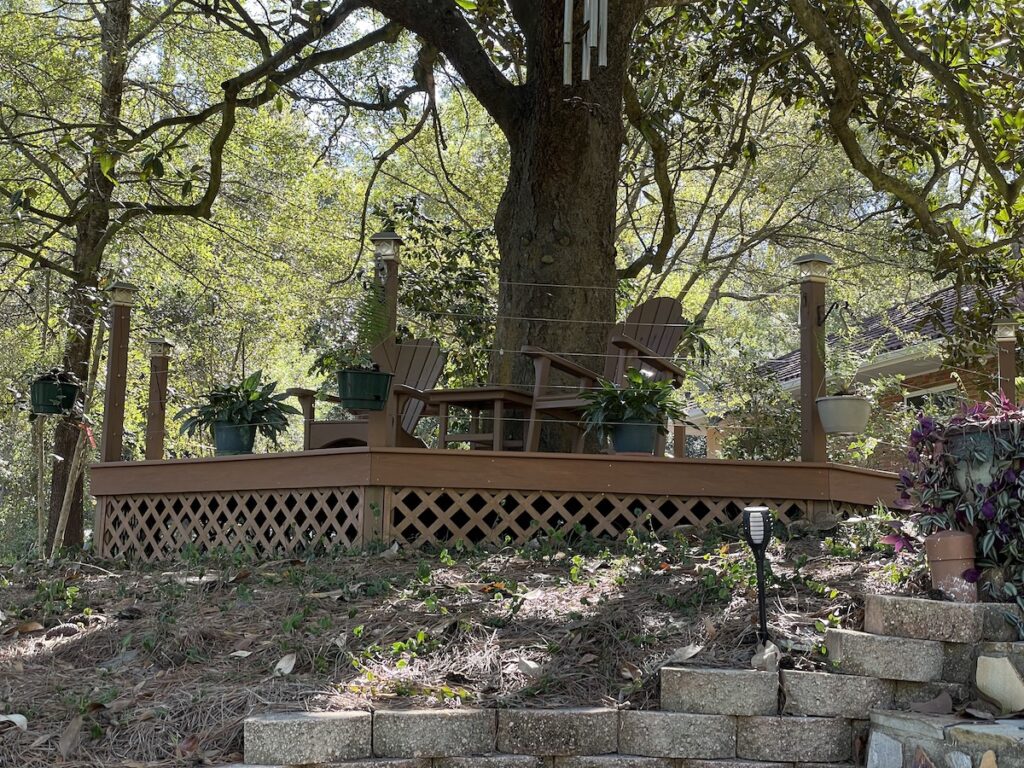
According to the stories, visitors in the early days could sit in a Shoo-fly under a large southern live oak tree to avoid deerflies, mosquitoes, and gnats and catch cool breezes. People who built shoo-flys usually built them around southern live oak trees.
This is because of the very large canopy that would completely cover the shoo-fly. Some of my friends who were born in the area did not know the name of the shoo-fly so I explained how they came to be.
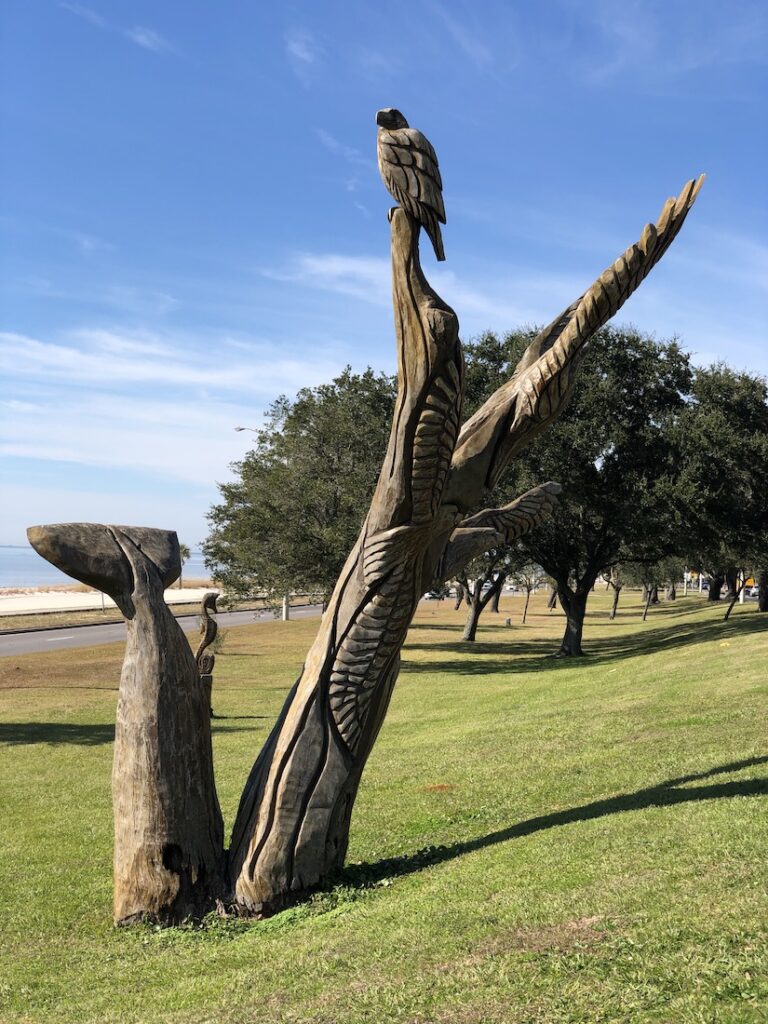
Trees can have a new life on the Gulf Coast
Local artists created art from trees damaged by hurricane Katrina. Drive along Beach Boulevard on the Gulf of Mexico, and reduce your speed. As you drive through Biloxi and Gulfport, look at the carvings in the median between east and westbound lanes in different locations.
Driving at the speed limit of 45 causes most of us to miss the majority of them. The photos above and below show a few of the many that line Beach Boulevard. In this way, some of those old majestic trees are still around to please us.
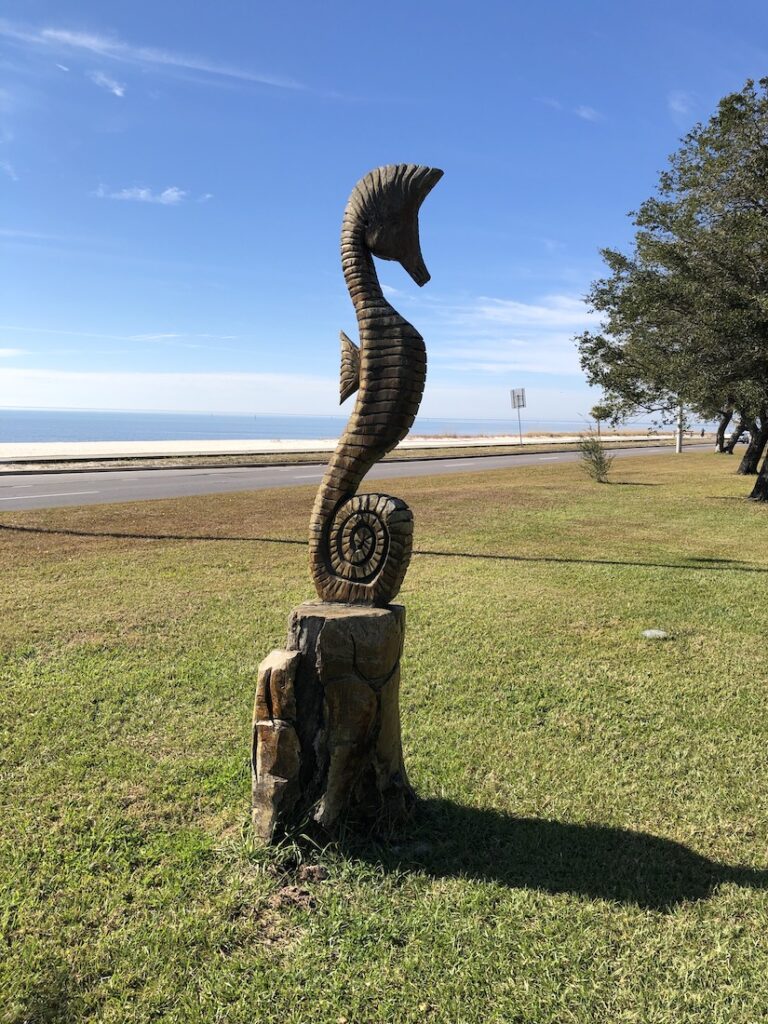
Garden Clubs protecting our heritage and beautifying the Coast
What do you know about your local gardening club? Something you probably do not know is that they are working day in and day out in your community to improve the plants and trees to help improve your city. My wife and I live near Ocean Springs and we love to have a breakfast bagel while sitting on the benches at Ft. Maurepas park on the front beach. The Ocean Springs Garden Club has done a great job keeping up the flowers and other plants in the park.
I have seen their small sign many times and all at once, I realized what a terrific job they are doing as unpaid stewards of our parks and public buildings. There is no doubt that they rarely receive the thanks they deserve for their dedicated work at no cost to the public. It’s a labor of love without a doubt. I suggest that you click here to visit the Garden Clubs of Mississippi, Inc. website to locate your local Garden Club. Perhaps you want to join or contribute.
The issue described above in Long Beach MS is being addressed by the Long Beach Garden Club. While the Club does not own the beautiful old live oaks and magnolia trees, they keep an eye out for their protection. You can read about their efforts by clicking here on their Facebook page. Many thanks to the members for bringing this issue to the attention of the public.
Difference between a Water Oak and a Live Oak
On the Mississippi Gulf Coast, one will often find both water and live oaks growing side by side. To the casual observer, they look similar. Water Oak (Quercus nigra) and Live Oak (Quercus virginiana) are both species of oak trees, but they have some distinct differences in their characteristics and growth habits. Here are some of the key differences between Water Oak and Live Oak:
- Growth Habit: Live Oak trees are known for their broad, spreading canopies and low-lying branches that often create a picturesque, sprawling appearance. Water Oak trees, on the other hand, typically have a more upright and pyramidal growth habit, with a narrower canopy.
- Leaf Shape and Persistence: The leaves of Live Oaks are usually elliptical or oval-shaped, with a leathery texture and wavy margins. Live Oak trees are considered evergreen, meaning they retain their leaves throughout the year and only shed older leaves as new ones grow. Water Oak leaves are more narrow and lanceolate, with smooth edges. Water Oak trees are generally considered deciduous, meaning they shed all of their leaves in the fall.
- Acorns: The acorns produced by these oak species also exhibit differences. Live Oaks typically produce small acorns with shallow cups, while Water Oaks produce larger acorns with deeper cups.
- Adaptability and Range: Live Oaks are native to the coastal regions of the southeastern United States and are well-adapted to the hot and humid climates found in those areas. They are more tolerant of salt spray and can withstand coastal winds. Water Oaks, on the other hand, have a wider range and can be found in various parts of the eastern and central United States, including both wetter and drier areas.
- Longevity: Live Oaks are known for their exceptional longevity and can live for several hundred years. Water Oaks, while still long-lived, typically have a shorter lifespan compared to Live Oaks.
- Preferred Habitat: Live Oaks prefer well-drained soils and are often found in coastal areas, sandy soils, and maritime forests. Water Oaks, as the name suggests, have a preference for wetter habitats and are commonly found near streams, swamps, and other areas with higher moisture levels.
It’s important to note that while these differences are generally observed, there can be some variation within each species due to factors such as soil conditions, climate, and individual tree characteristics.
What about the Magnolia trees?
While this article focuses on the area of the Gulf Coast near the beach with live oaks, you can find them inland as well. The southern live oak is not the only tree to watch for when you visit the Mississippi Gulf Coast. Some of the best places to see the southern live oaks will also give you views of some truly giant magnolia trees which are the state tree.
As with the oaks, magnolia trees are another treasure. They produce giant flowers each year that residents love. Their sweet scent is very pleasant. The older areas of the Coast which include Gulfport, Biloxi, Ocean Springs, Pass Christian, Long Beach, and Bay St. Louis our favorite places to see these great trees and enjoy the quaint downtown areas.
Don’t forget to take the 15.5-mile round-trip Live Oaks Bicycle Route in old town Ocean Springs. Follow the green and white bike-route signs on the right side of the city streets. You can collect a map at the Ocean Springs Chamber of Commerce located at the old Louisville and Nashville train depot.
Trim those trees
Before you start trimming live oaks and magnolias, check your local ordinances. You can generally trim recent growth that blocks driveways or extends over houses. You want to keep your tree healthy but you have to live with it too. Every year I have to trim one of my very large live oaks because new growth blocks the driveway. Read more about this topic here: https://retirecoast.com/trim-your-trees-now-or-lose-homeowners-insurance-coverage/
Visit the Mississippi Gulf Coast and see for yourself
I hope that you have enjoyed this article. Logan-Anderson Gulf Coastal Realtors can help you with any questions about the Mississippi Gulf Coast. If you love this great place when you arrive, consider staying. Many of us who have come from other parts of the country have found the beautiful tree-lined streets and the terrific people who are passionate about their communities to be a breath of fresh air.
We call this place the “secret coast” or the “best coast” and there are good reasons for this. Our southern live oak trees are just one (a big reason) reason to come visit.
Thank you for reading our article. Please sign up on the top left of this article to receive notices of new articles.




